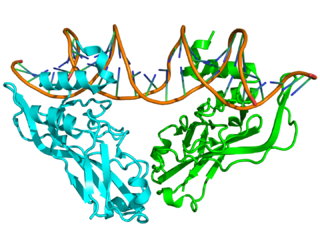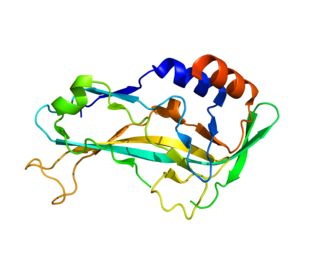Related Research Articles
The development of the nervous system, or neural development, or neurodevelopment, refers to the processes that generate, shape, and reshape the nervous system of animals, from the earliest stages of embryonic development to adulthood. The field of neural development draws on both neuroscience and developmental biology to describe and provide insight into the cellular and molecular mechanisms by which complex nervous systems develop, from nematodes and fruit flies to mammals.

Sonic hedgehog is a protein that, in humans, is encoded by the SHH gene. It is the best-studied ligand of the hedgehog signaling pathway; others are desert hedgehog (DHH) and Indian hedgehog (IHH). It plays a key role in the development of animals from insects to mammals. In vertebrates, it is involved in organogenesis, including the growth of digits on limbs and the organization of the brain. Sonic hedgehog is an archetypal example of a morphogen as defined by Lewis Wolpert's French flag model — i.e., a molecule that diffuses to form a concentration gradient and has different effects on the cells of the developing embryo, depending on its concentration. Sonic hedgehog is also active in adults; for example, it controls the proliferation of adult stem cells and has been implicated in the development of some cancers.

Lewis WolpertCBE FRS FRSL FMedSci is a South African-born British developmental biologist, author, and broadcaster. Wolpert is recognized for his work on the intracellular positional information that guides cellular development. In addition, he has published several popular science books.

Lateral plate mesoderm is a type of mesoderm that is found at the periphery of the embryo.

The apical ectodermal ridge (AER) is a structure that forms from the ectodermal cells at the distal end of each limb bud and acts as a major signaling center to ensure proper development of a limb. After the limb bud induces AER formation, the AER and limb mesenchyme—including the zone of polarizing activity (ZPA)—continue to communicate with each other to direct further limb development.

Ectrodactyly–ectodermal dysplasia–cleft syndrome, or EEC, and also referred to as EEC syndrome and split hand–split foot–ectodermal dysplasia–cleft syndrome is a rare form of ectodermal dysplasia, an autosomal dominant disorder inherited as a genetic trait. EEC is characterized by the triad of ectrodactyly, ectodermal dysplasia, and facial clefts. Other features noted in association with EEC include vesicoureteral reflux, recurrent urinary tract infections, obstruction of the nasolacrimal duct, decreased pigmentation of the hair and skin, missing or abnormal teeth, enamel hypoplasia, absent punctae in the lower eyelids, photophobia, occasional cognitive impairment and kidney anomalies, and conductive hearing loss.

Limb development in vertebrates is an area of active research in both developmental and evolutionary biology, with much of the latter work focused on the transition from fin to limb.
The limb bud is a structure formed early in vertebrate limb development. As a result of interactions between the ectoderm and underlying mesoderm, formation occurs roughly around the fourth week of development. In the development of the human embryo the upper limb bud appears in the third week and the lower limb bud appears four days later.

T-box refers to a group of transcription factors involved in embryonic limb and heart development. Every T-box protein has a relatively large DNA-binding domain, generally comprising about a third of the entire protein that is both necessary and sufficient for sequence-specific DNA binding. All members of the T-box gene family bind to the "T-box", a DNA consensus sequence of TCACACCT.

Fibroblast growth factor 10 is a protein that in humans is encoded by the FGF10 gene.

T-box transcription factor TBX5 is a protein that in humans is encoded by the TBX5 gene.

Fibroblast growth factor 8 is a protein that in humans is encoded by the FGF8 gene.

Homeobox protein EMX1 is a protein that in humans is encoded by the EMX1 gene. The transcribed EMX1 gene is a member of the EMX family of transcription factors. The EMX1 gene, along with its family members, are expressed in the developing cerebrum. Emx1 plays a role in specification of positional identity, the proliferation of neural stem cells, differentiation of layer-specific neuronal phenotypes and commitment to a neuronal or glial cell fate.

Gail Roberta Martin is an American biologist. She is professor emerita in the Department of Anatomy, University of California, San Francisco. She is known for her pioneering work on the isolation of pluripotent stem cells from normal embryos, for which she coined the term ‘embryonic stem cells’. She is also widely recognized for her work on the function of Fibroblast Growth Factors (FGFs) and their negative regulators in vertebrate organogenesis. She and her colleagues also made valuable contributions to gene targeting technology.
Cheryll Anne Tickle is a distinguished British scientist, known for her work in developmental biology and specifically for her research into the process by which vertebrate limbs develop ab ovo. She is an Emeritus Professor at the University of Bath.

The zone of polarizing activity (ZPA) is an area of mesenchyme that contains signals which instruct the developing limb bud to form along the anterior/posterior axis. Limb bud is undifferentiated mesenchyme enclosed by an ectoderm covering. Eventually, the limb bud develops into bones, tendons, muscles and joints. Limb bud development relies not only on the ZPA, but also many different genes, signals, and a unique region of ectoderm called the apical ectodermal ridge (AER). Research by Saunders and Gasseling in 1948 identified the AER and its subsequent involvement in proximal distal outgrowth. Twenty years later, the same group did transplantation studies in chick limb bud and identified the ZPA. It wasn't until 1993 that Todt and Fallon showed that the AER and ZPA are dependent on each other.
Temporal feedback, also referred to as interlinked or interlocked feedback, is a biological regulatory motif in which fast and slow positive feedback loops are interlinked to create "all or none" switches. This interlinking produces separate, adjustable activation and de-activation times. This type of feedback is thought to be important in cellular processes in which an "all or none" decision is a necessary response to a specific input. The mitotic trigger, polarization in budding yeast, mammalian calcium signal transduction, EGF receptor signaling, platelet activation, and Xenopus oocyte maturation are examples for interlinked fast and slow multiple positive feedback systems.
Epimorphosis is defined as the regeneration of a specific part of an organism in a way that involves extensive cell proliferation of somatic stem cells, dedifferentiation, and reformation, as well as blastema formation. Epimorphosis can be considered a simple model for development, though it only occurs in tissues surrounding the site of injury rather than occurring system-wide. Epimorphosis restores the anatomy of the organism and the original polarity that existed before the destruction of the tissue and/or a structure of the organism. Epimorphosis regeneration can be observed in both vertebrates and invertebrates such as the common examples: salamanders, annelidas, and planarians.
T-box transcription factor Tbx4 is a transcription factor that belongs to T-box gene family that is involved in the regulation of embryonic developmental processes. The transcription factor is encoded by the TBX4 gene located on human chromosome 17. Tbx4 is known mostly for its role in the development of the hindlimb, but it also plays a critical role in the formation of the umbilicus. Tbx4 has been shown to be expressed in the allantois, hindlimb, lung and proctodeum.

Beta-1,3-N-acetylglucosaminyltransferase radical fringe, also known as radical fringe is a protein that in humans is encoded by the RFNG gene. Radical fringe is a signaling enzyme involved in the arrangement of the embryonic limb buds. It is a member of the fringe gene family, which also includes manic fringe and lunatic fringe. It is important for the dorsoventrally patterning of the limb and has been implicated in the formation of the apical ectodermal ridge (AER). The AER is essential for the distal patterning of the limb. Experiments executed in chicken models show Radical fringe is expressed in both the dorsal ectoderm and the AER. This provides evidence that the AER forms from cells already expressing radical fringe, though further evidence is needed to confirm. Grafting experiments have shown that formation of the AER comes from signals in the limb bud mesoderm. However, radical fringe acts as a permissive signal to create a boundary for the AER to form. The knockout experiments done in chicken models suggest Radical fringe plays an integral role in wing development.
References
- ↑ Summerbell, D.; Lewis, J. H.; Wolpert, L. (1973). "Positional Information in Chick Limb Morphogenesis". Nature. 244: 492–496. doi:10.1038/244492a0. PMID 4621272.
- ↑ Dudley, A. T.; Ros, M. A.; Tabin, C. (2002). "A re-examination of proximodistal patterning during vertebrate limb development". Nature. 418: 539–544. doi:10.1038/nature00945. PMID 12152081.
- ↑ Wolpert, Lewis (2002). "The Progress Zone Model for specifying Positional Information". The International Journal of Developmental Biology. 46: 869–870 – via ijdb.ehu.
| This developmental biology article is a stub. You can help Wikipedia by expanding it. |